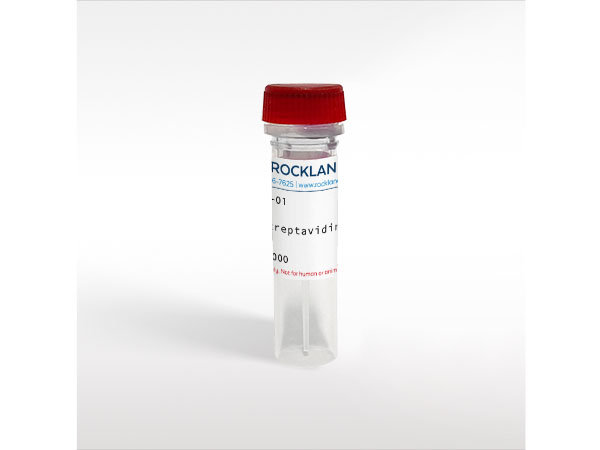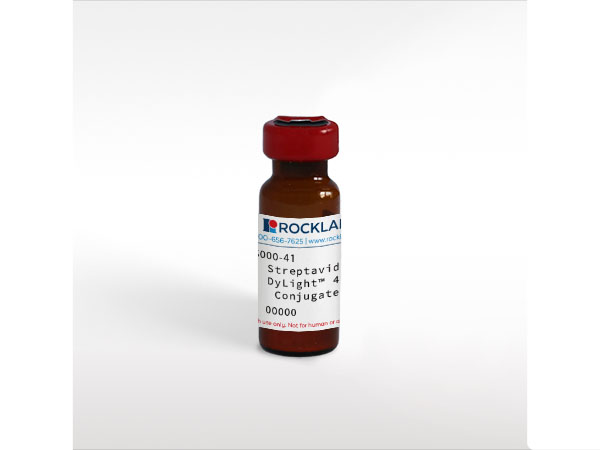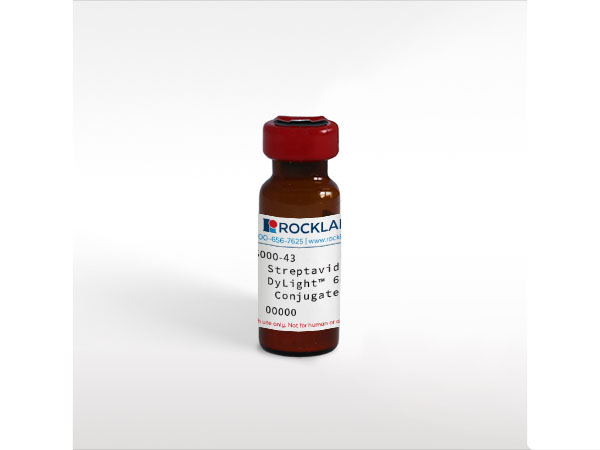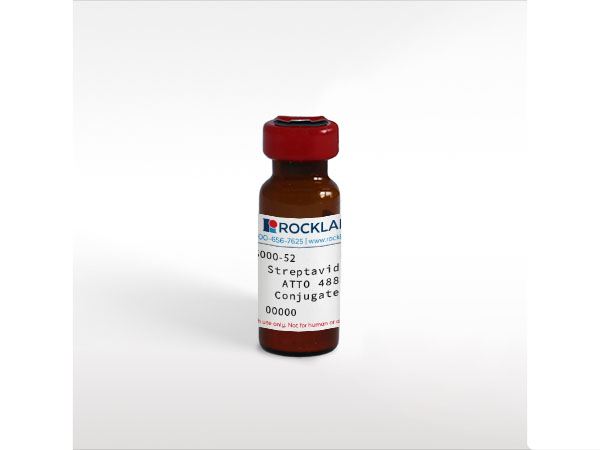Streptavidin Peroxidase Conjugated
37 References
S000-03
1 mg
Lyophilized
WB, ELISA, IHC, IF, Dot Blot, EM, Other
Shipping info:
$50.00 to US & $70.00 to Canada for most products. Final costs are calculated at checkout.
Product Details
Streptavidin Peroxidase Conjugated - S000-03
HRP-SA, Horseradish Peroxidase conjugated S avidin, Streptavidin HRP, Streptavidin conjugated to horseradish peroxidase (HRP), HRP-linked Streptavidin
Peroxidase (HRP)
Target Details
Streptavidin-HRP was prepared from chromatographically purified streptavidin. Streptavidin Peroxidase conjugate was assayed by immunoelectrophoresis resulted in a single precipitin arc against anti-Peroxidase and anti-Streptavidin.
P22629 - UniProtKB
CAA00084.1 - NCBI Protein
Application Details
Dot Blot, WB
ELISA, EM, IF, IHC, Other
- View References
Streptavidin Peroxidase has been tested by dot blot and western blot and is a useful detection reagent for primary antibodies conjugated to biotin. Streptavidin Peroxidase can be utilized in Immunohistochemistry, Immunofluorescence, immuno-EM, Western Blotting, and ELISA experiment formats in combination with the proper substrate (TMB-1000 or FEMTOMAX-110).
Formulation
1.0 mg/mL by UV absorbance at 280 nm
0.02 M Potassium Phosphate, 0.15 M Sodium Chloride, pH 7.2
0.01% (w/v) Gentamicin Sulfate. Do NOT add Sodium Azide!
10 mg/mL Bovine Serum Albumin (BSA) - Immunoglobulin and Protease free
1.0 mL
Restore with deionized water (or equivalent)
Shipping & Handling
Ambient
Store vial at 4° C prior to restoration. For extended storage aliquot contents and freeze at -20° C or below. Avoid cycles of freezing and thawing. Centrifuge product if not completely clear after standing at room temperature. Streptavidin Peroxidase conjugated is stable for several weeks at 4° C as an undiluted liquid. Dilute only prior to immediate use.
Expiration date is one (1) year from date of receipt.
Streptavidin is isolated from bacteria, Streptomyces avidinii, and has an exceptionally high binding affinity for B7 (biotin). Rockland offers streptavidin in unconjugated and conjugated forms for common immunoassays including ELISA, western blotting, immunohistochemistry. Streptavidin is a tetrameric protein capable of binding 4 biotin groups to each molecule of streptavidin. While streptavidin has identical binding properties as avidin, it lacks the glycoprotein portion of the molecule and therefore shows less non-specific binding. Streptavidin is a slightly smaller molecule with a molecular weight of approximately 53.6 kDa. The sequence of avidin only shows 30% homology with streptavidin, and anti-avidin and anti-streptavidin antibodies are not immunologically cross reactive. Horseradish Peroxidase (HRP) is an enzyme that utilize organic peroxide compounds as electron donors. Naturally provides protection for plants against pathogens, but can be utilized in molecular biology to convert various substrates to detectable compounds (such as in Western Blotting and ELISAs).
Ruz-Maldonado I et al. (2024). Heterogeneity of hepatocyte dynamics restores liver architecture after chemical, physical or viral damage. Nat Commun.
Applications
IHC, ICC, Histology
Sun J et al. (2024). Fatty acid binding protein 5 suppression attenuates obesity-induced hepatocellular carcinoma by promoting ferroptosis and intratumoral immune rewiring. Nat Metab.
Applications
Other
Lopez-Tello J et al. (2023). Fetal manipulation of maternal metabolism is a critical function of the imprinted Igf2 gene. Cell Metab.
Applications
IHC, ICC, Histology
Mishra KP et al. (2023). Development of ELISA-Based Assay for Detection of SARS-CoV-2 Neutralizing Antibody. Viral Immunol.
Applications
Other
Ghezzi L et al. (2023). Schwann Cell Remyelination in the Multiple Sclerosis Central Nervous System. Lab Invest.
Applications
IHC, ICC, Histology
Reuss S et al. (2023). Synaptoporin and parathyroid hormone 2 as markers of multimodal inputs to the auditory brainstem. J Chem Neuroanat.
Applications
IHC, ICC, Histology
Lopez-Tello, J et sl. (2022). Ablation of PI3K-p110alpha Impairs Maternal Metabolic Adaptations to Pregnancy. Frontiers in Cell and Developmental Biology
Applications
IHC, ICC, Histology
Lopez-Tello, J et al. (2022). Identification of Structural and Molecular Signatures Mediating Adaptive Changes in the Mouse Kidney in Response to Pregnancy. International Journal of Molecular Sciences
Applications
IHC, ICC, Histology
Napso T et al. (2022). Diet-induced maternal obesity impacts feto-placental growth and induces sex-specific alterations in placental morphology, mitochondrial bioenergetics, dynamics, lipid metabolism and oxidative stress in mice. Acta Physiol (Oxf).
Applications
IHC, ICC, Histology
Aykroyd BRL et al. (2022). Loss of imprinting of the Igf2-H19 ICR1 enhances placental endocrine capacity via sex-specific alterations in signalling pathways in the mouse. Development.
Applications
IHC, ICC, Histology
Sandovici I et al. (2022). The imprinted Igf2-Igf2r axis is critical for matching placental microvasculature expansion to fetal growth. Dev Cell.
Applications
IHC, ICC, Histology
Lean SC et al. (2022). Obesogenic diet in mice compromises maternal metabolic physiology and lactation ability leading to reductions in neonatal viability. Acta Physiol (Oxf).
Applications
IHC, ICC, Histology
Krilis M et al. (2021). Clinical relevance of nitrated beta 2-glycoprotein I in antiphospholipid syndrome: Implications for thrombosis risk. J Autoimmun.
Applications
Undefined
Mátyás, A et al. (2021). Hippocampal Sclerosis in Pilocarpine Epilepsy: Survival of Peptide-Containing Neurons and Learning and Memory Disturbances in the Adult NMRI Strain Mouse. International Journal of Molecular Sciences
Applications
IHC, ICC, Histology
Trujillo-Cenoz O et al. (2021). The ependymal cell cytoskeleton in the normal and injured spinal cord of mice. J Neurosci Res.
Applications
Undefined
De Clercq K. et al. (2020). Double-label immunohistochemistry to assess labyrinth structure of the mouse placenta with stereology. Placenta
Applications
IHC, ICC, Histology
Napso T, Hung YP, Davidge ST, Care AS, Sferruzzi-Perri AN. (2020). Advanced maternal age compromises fetal growth and induces sex-specific changes in placental phenotype in rats. Sci Rep.
Applications
IHC, ICC, Histology
Aykroyd BRL, Tunster SJ, Sferruzzi-Perri AN. (2020). Igf2 deletion alters mouse placenta endocrine capacity in a sexually dimorphic manner. J Endocrinol.
Applications
Undefined
Huang MS, Lin WC, Chang JH, Cheng CH, Wang HY, Mou KY. (2019). The cysteine-free single mutant C32S of APEX2 is a highly expressed and active fusion tag for proximity labeling applications. Protein Sci.
Applications
WB, IB, PCA
Sozen B, Cox AL, De Jonghe J, et al. (2019). Self-Organization of Mouse Stem Cells into an Extended Potential Blastoid. Dev Cell.
Applications
IHC, ICC, Histology
López-Tello J, Pérez-García V, Khaira J, et al. (2019). Fetal and trophoblast PI3K p110α have distinct roles in regulating resource supply to the growing fetus in mice. Elife.
Applications
IF, Confocal Microscopy
Kühnle A et al. (2019). Polysialic Acid Modulates the Binding of External Lactoferrin in Neutrophil Extracellular Traps. Biology (Basel).
Applications
WB, IB, PCA
Napso, T et al. (2019). Advanced maternal age compromises fetal growth and induces sex-specific changes in placental phenotype in rats. Scientific Reports
Applications
IHC, ICC, Histology
Elisa Balmas et al. (2018). Maternal group 2 innate lymphoid cells control fetal growth and protect from endotoxin-induced abortion in mice. bioRxiv
Applications
IHC, ICC, Histology
Batarseh YS et al. (2017). Oleocanthal ameliorates amyloid-β oligomers' toxicity on astrocytes and neuronal cells: In vitro studies. Neuroscience
Applications
E, EIA
Tatsukawa, H et al. (2017). Global identification and analysis of isozyme-specific possible substrates crosslinked by transglutaminases using substrate peptides in mouse liver fibrosis. Scientific Reports
Applications
EIA, ELISA
Phillips et al. (2016). Entry Sites of Venezuelan and Western Equine Encephalitis Viruses in the Mouse Central Nervous System following Peripheral Infection. Journal of Virology
Applications
IHC, ICC, Histology
Vasek MJ, Garber C, Dorsey D, et al. (2016). A complement-microglial axis drives synapse loss during virus-induced memory impairment. Nature.
Applications
Immuno-EM
Cantoni C, Bollman B, Licastro D, et al. (2015). TREM2 regulates microglial cell activation in response to demyelination in vivo. Acta Neuropathol.
Applications
Immuno-EM
Matveev SV et al. (2014). A distinct subfraction of Aβ is responsible for the high-affinity Pittsburgh compound B-binding site in Alzheimer's disease brain. Journal of Neurochemistry
Applications
E, EIA
LeVine H et al. (2012). Dihydroxybenzoic acid isomers differentially dissociate soluble biotinyl-Aβ(1-42) oligomers. Biochemistry
Applications
E, EIA
Cowles CE, Li Y, Semmelhack MF, Cristea IM, Silhavy TJ. (2011). The free and bound forms of Lpp occupy distinct subcellular locations in Escherichia coli. Mol Microbiol.
Applications
WB, IB, PCA
Didenko, VV. et al. (2011). In situ labeling of DNA breaks and apoptosis by T7 DNA polymerase. Methods in Molecular Biology (Clifton, N.J.)
Applications
IHC, ICC, Histology
Tanaka, M et al. (2011). An assay for RNA oxidation induced abasic sites using the Aldehyde Reactive Probe. Free Radical Research
Applications
WB, IB, PCA
Borbulevych, OY et al. (2011). Conformational melding permits a conserved binding geometry in TCR recognition of foreign and self molecular mimics. Journal of Immunology (Baltimore, Md. : 1950)
Applications
SPR-Based Analyses
Pompe T, Salchert K, Alberti K, Zandstra P, Werner C. (2010). Immobilization of growth factors on solid supports for the modulation of stem cell fate. Nat Protoc.
Applications
E, EIA
Sferruzzi-Perri AN, Macpherson AM, Roberts CT, Robertson SA. (2009). Csf2 null mutation alters placental gene expression and trophoblast glycogen cell and giant cell abundance in mice. Biol Reprod.
Applications
IHC, ICC, Histology
This product is for research use only and is not intended for therapeutic or diagnostic applications. Please contact a technical service representative for more information. All products of animal origin manufactured by Rockland Immunochemicals are derived from starting materials of North American origin. Collection was performed in United States Department of Agriculture (USDA) inspected facilities and all materials have been inspected and certified to be free of disease and suitable for exportation. All properties listed are typical characteristics and are not specifications. All suggestions and data are offered in good faith but without guarantee as conditions and methods of use of our products are beyond our control. All claims must be made within 30 days following the date of delivery. The prospective user must determine the suitability of our materials before adopting them on a commercial scale. Suggested uses of our products are not recommendations to use our products in violation of any patent or as a license under any patent of Rockland Immunochemicals, Inc. If you require a commercial license to use this material and do not have one, then return this material, unopened to: Rockland Inc., P.O. BOX 5199, Limerick, Pennsylvania, USA.






